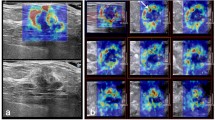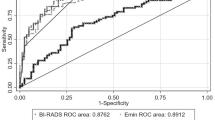Abstract
Objective
To evaluate which shear wave elastography (SWE) parameter proves most accurate in the differential diagnosis of solid breast masses.
Methods
One hundred and fifty-six breast lesions in 139 consecutive women (mean age: 43.54 ± 9.94 years, range 21–88 years), who had been scheduled for ultrasound-guided breast biopsy, were included. Conventional ultrasound and SWE were performed in all women before biopsy procedures. Ultrasound BI-RADS final assessment and SWE parameters were recorded. Diagnostic performance of each SWE parameter was calculated and compared with those obtained when applying cut-off values of previously published data. Performance of conventional ultrasound and ultrasound combined with each parameter was also compared.
Results
Of the 156 breast masses, 120 (76.9 %) were benign and 36 (23.1 %) malignant. Maximum stiffness (Emax) with a cut-off of 82.3 kPa had the highest area under the receiver operating characteristics curve (Az) value compared with other SWE parameters, 0.860 (sensitivity 88.9 %, specificity 77.5 %, accuracy 80.1 %). Az values of conventional ultrasound combined with each SWE parameter showed lower (but not significantly) values than with conventional ultrasound alone.
Conclusions
Maximum stiffness (82.3 kPa) provided the best diagnostic performance. However the overall diagnostic performance of ultrasound plus SWE was not significantly better than that of conventional ultrasound alone.
Key Points
• SWE offers new information over and above conventional breast ultrasound
• Various SWE parameters were explored regarding distinction between benign and malignant lesions
• An elasticity of 82.3 kPa appears optimal in differentiating solid breast masses
• However, ultrasound plus SWE was not significantly better than conventional ultrasound alone



Similar content being viewed by others
References
Burnside ES, Hall TJ, Sommer AM et al (2007) Differentiating benign from malignant solid breast masses with US strain imaging. Radiology 245:401–410
Regner DM, Hesley GK, Hangiandreou NJ et al (2006) Breast lesions: evaluation with US strain imaging—clinical experience of multiple observers. Radiology 238:425–437
Itoh A, Ueno E, Tohno E et al (2006) Breast disease: clinical application of US elastography for diagnosis. Radiology 239:341–350
Yoon JH, Kim MH, Kim EK, Moon HJ, Kwak JY, Kim MJ (2011) Interobserver variability of ultrasound elastography: how it affects the diagnosis of breast lesions. AJR Am J Roentgenol 196:730–736
Athanasiou A, Tardivon A, Tanter M et al (2010) Breast lesions: quantitative elastography with supersonic shear imaging—preliminary results. Radiology 256:297–303
Chang JM, Moon WK, Cho N et al (2011) Clinical application of shear wave elastography (SWE) in the diagnosis of benign and malignant breast diseases. Breast Cancer Res Treat 129:89–97
Cosgrove DO, Berg WA, Dore CJ et al (2012) Shear wave elastography for breast masses is highly reproducible. Eur Radiol 22:1023–1032
Tozaki M, Fukuma E (2011) Pattern classification of ShearWave Elastography images for differential diagnosis between benign and malignant solid breast masses. Acta Radiol 52:1069–1075
Berg WA, Cosgrove DO, Dore CJ et al (2012) Shear-wave elastography improves the specificity of breast US: the BE1 multinational study of 939 masses. Radiology 262:435–449
Evans A, Whelehan P, Thomson K et al (2010) Quantitative shear wave ultrasound elastography: initial experience in solid breast masses. Breast Cancer Res 12:R104
Gweon HM, Youk JH, Son EJ, Kim JA (2013) Visually assessed colour overlay features in shear-wave elastography for breast masses: quantification and diagnostic performance. Eur Radiol 23:658-663
American College of Radiology (2003) Breast imaging reporting and data system. American College of Radiology, Reston
Balleyguier C, Canale S, Hassen WB et al (2012) Breast elasticity: principles, technique, results: an update and overview of commercially available software. Eur J Radiol. doi:10.1016/j.ejrad.2012.03.001
Evans A, Whelehan P, Thomson K et al (2012) Differentiating benign from malignant solid breast masses: value of shear wave elastography according to lesion stiffness combined with greyscale ultrasound according to BI-RADS classification. Br J Cancer 107:224–229
Evans A, Whelehan P, Thomson K et al (2012) Invasive breast cancer: relationship between shear-wave elastographic findings and histologic prognostic factors. Radiology 263:673–677
Tanter M, Bercoff J, Athanasiou A et al (2008) Quantitative assessment of breast lesion viscoelasticity: initial clinical results using supersonic shear imaging. Ultrasound Med Biol 34:1373–1386
Lee SH, Chang JM, Kim WH et al (2012) Differentiation of benign from malignant solid breast masses: comparison of two-dimensional and three-dimensional shear-wave elastography. Eur Radiol. doi:10.1007/s00330-012-2686-9
Lazarus E, Mainiero MB, Schepps B, Koelliker SL, Livingston LS (2006) BI-RADS lexicon for US and mammography: interobserver variability and positive predictive value. Radiology 239:385–391
Lee HJ, Kim EK, Kim MJ et al (2008) Observer variability of Breast Imaging Reporting and Data System (BI-RADS) for breast ultrasound. Eur J Radiol 65:293–298
Crystal P, Koretz M, Shcharynsky S, Makarov V, Strano S (2005) Accuracy of sonographically guided 14-gauge core-needle biopsy: results of 715 consecutive breast biopsies with at least two-year follow-up of benign lesions. J Clin Ultrasound 33:47–52
Youk JH, Kim EK, Kim MJ, Kwak JY, Son EJ (2009) Analysis of false-negative results after US-guided 14-gauge core needle breast biopsy. Eur Radiol 20:782–789
Youk JH, Kim E, Kim MJ, Oh KK (2008) Sonographically guided 14-gauge core needle biopsy of breast masses: a review of 2,420 cases with long-term follow-up. AJR Am J Roentgenol 190:202–207
Sadigh G, Carlos RC, Neal CH, Wojcinski S, Dwamena BA (2012) Impact of breast mass size on accuracy of ultrasound elastography vs. conventional B-mode ultrasound: a meta-analysis of individual participants. Eur Radiol. doi:10.1007/s00330-012-2682-0
Author information
Authors and Affiliations
Corresponding author
Rights and permissions
About this article
Cite this article
Lee, E.J., Jung, H.K., Ko, K.H. et al. Diagnostic performances of shear wave elastography: which parameter to use in differential diagnosis of solid breast masses?. Eur Radiol 23, 1803–1811 (2013). https://doi.org/10.1007/s00330-013-2782-5
Received:
Revised:
Accepted:
Published:
Issue Date:
DOI: https://doi.org/10.1007/s00330-013-2782-5




